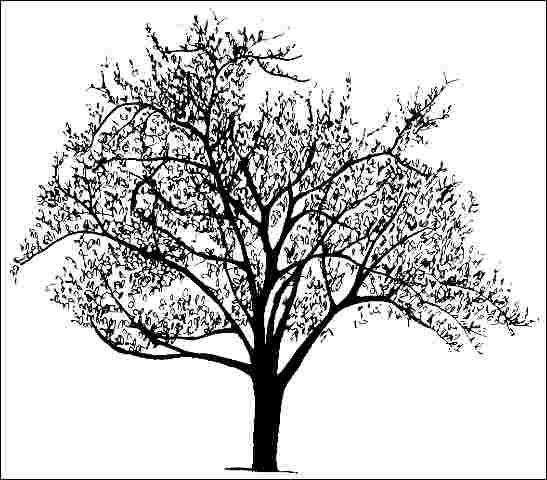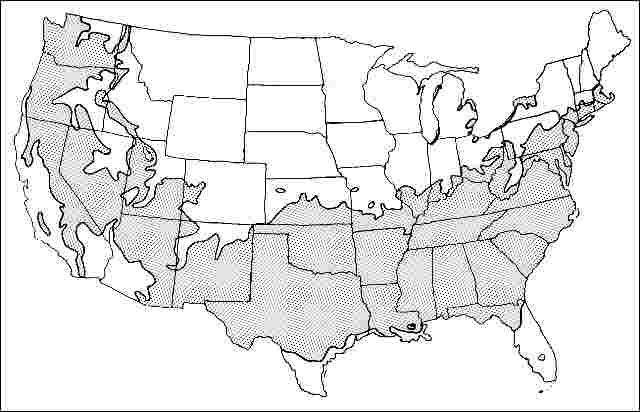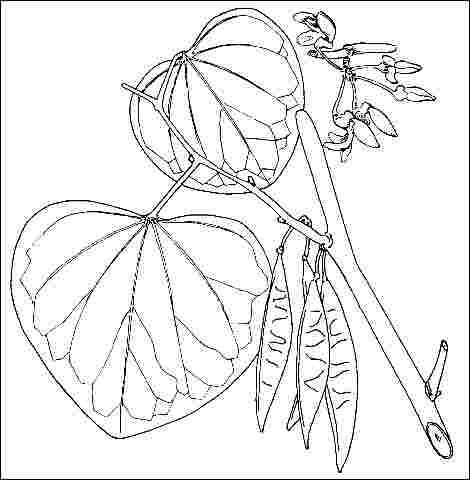Introduction
`Forest Pansy' Eastern Redbud is a moderate to rapid-grower, 20 to 30 feet in height, which has red twigs and beautiful, shimmering, purple/red new leaves, which fade to purple/green during the summer in its southern range (USDA hardiness zones 7, 8 and 9). The veins on the backs of the leaves are a deep maroon and make a striking contrast with the light grey/green leaf. The splendid, purple/pink flowers appear all over the tree in spring, just before the leaves emerge. `Forest Pansy' Eastern Redbud has an irregular growth habit when young but forms a graceful, flat-topped, vase shape as it gets older. The tree usually branches low on the trunk, and if left intact forms a graceful multitrunked habit. Be sure to avoid weak forks by pruning to reduce the size of the lateral branches and save those which form `U'-shaped crotches, not a `V'-shaped crotch. Keep them less than half the diameter of the main trunk to prevent branch splitting. This will increase the longevity of the tree.

General Information
Scientific name: Cercis canadensis
Pronunciation: SER-sis kan-uh-DEN-sis
Common name(s): 'Forest Pansy' Eastern Redbud
Family: Leguminosae
USDA hardiness zones: 6A through 8B (Fig. 2)
Origin: native to North America
Invasive potential: little invasive potential
Uses: container or planter; tree lawn 3-4 feet wide; tree lawn 4-6 feet wide; tree lawn > 6 ft wide; street without sidewalk; sidewalk cutout (tree pit); parking lot island < 100 sq ft; parking lot island 100-200 sq ft; parking lot island > 200 sq ft; deck or patio; shade; specimen; reclamation; highway median
Availability: somewhat available, may have to go out of the region to find the tree

Description
Height: 20 to 30 feet
Spread: 15 to 25 feet
Crown uniformity: irregular
Crown shape: vase, round
Crown density: moderate
Growth rate: fast
Texture: coarse
Foliage
Leaf arrangement: alternate (Fig. 3)
Leaf type: simple
Leaf margin: entire
Leaf shape: ovate
Leaf venation: palmate, reticulate, brachidodrome, pinnate
Leaf type and persistence: deciduous
Leaf blade length: 2 to 4 inches, 4 to 8 inches
Leaf color: purple/red, green
Fall color: yellow
Fall characteristic: showy
Flower
Flower color: pink, lavender, purple
Flower characteristics: very showy
Fruit
Fruit shape: pod or pod-like
Fruit length: 1 to 3 inches
Fruit covering: dry or hard
Fruit color: brown
Fruit characteristics: does not attract wildlife; showy; fruit/leaves not a litter problem
Trunk and Branches
Trunk/bark/branches: branches droop; not showy; typically multi-trunked; thorns
Pruning requirement: needed for strong structure
Breakage: susceptible to breakage
Current year twig color: brown
Current year twig thickness: medium
Wood specific gravity: unknown
Culture
Light requirement: full sun, partial sun or partial shade
Soil tolerances: sand; loam; clay; acidic; alkaline; occasionally wet; well-drained
Drought tolerance: high
Aerosol salt tolerance: none
Other
Roots: not a problem
Winter interest: no
Outstanding tree: yes
Ozone sensitivity: unknown
Verticillium wilt susceptibility: susceptible
Pest resistance: resistant to pests/diseases

Use and Management
Yellow (although somewhat variable and unreliable) fall color and tolerance to partial shade make this a suitable, attractive tree for understory or specimen planting. Low branching habit makes it ideal for specimen, deck or patio planting, and it is especially suited for planting on 15-foot-centers on both sides of an entry walk or driveway. Best not used as a street tree due to low disease resistance and short life, it is nice in commercial and residential landscapes, or as an accent in a shrubbery border.
Eastern Redbuds grow well in full sun in the northern part of its range but will benefit from some shade in the southern zones, particularly in the lower mid-west where summers are hot. The best growth occurs in a light, rich, moist soil but Eastern Redbud adapts well to a variety of soils, including sandy, clay or alkaline. Trees look better when they receive some irrigation in summer dry spells, particularly if the tree is planted in an area where the roots are confined. Young trees survive best when transplanted in the spring or fall but containerized trees can be planted anytime. Eastern Redbud fixes its own nitrogen, so only light (if any) nitrogen fertilizer is recommended. The beans provide food for some birds. `Forest Pansy' may be less adapted to drought than the species.
Propagated by cuttings.
Pests
Treehoppers lay eggs under the bark of twigs. The insect itself is not seen but the white, sticky froth covering the eggs is quite noticeable.
Scale insects can usually be controlled with horticultural sprays.
Webworm can devour leaves on portions of the tree.
Diseases
Canker is the biggest problem with Eastern Redbud. The fungus enters through wounds or dead and dying branches. Dieback begins as a canker on a branch. The cankers, at first small and sunken, enlarge to girdle the branch. Bark in the canker turns black and a crack forms between diseased and healthy bark. Once girdled, the part of the stem beyond the canker wilts and dies. There is no chemical control. Prune out diseased branches.
Leaf spots can be a problem during wet weather. Since the disease is rarely serious, no chemical controls are suggested.
Verticillium wilt attacks and kills Eastern Redbud. Fertilize affected trees and prune out wilted branches.